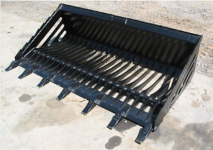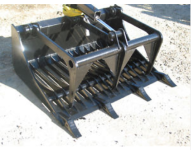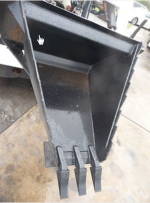and new to this web site. This is a long post. I have decided on a LS, independently of this site which I just discovered, for all of the reasons most folks here have expressed and also found what I feel is probably a great dealer in Hartley Enterprises, Monetta, SC, that is 55 miles away. Hartley also sells Mahindra. And they automatically load the rear tires on any tractor they sell with a FEL.
I spent a lot of time test driving tractors. But LS is by far the best bang for the buck and had the only HST models that fit how I would want to use the go pedals. For just a little bit more, the R4041 is a lot more tractor, in my opinion. But I have to temper this as I believe a R3039 is all I need and its smaller size would work out better after the clearing is done.
I have read many posts and have learned a lot from the responses. This is my first real tractor and I will be using it to clear a 2 acre home site on 4.4 acres of densely wooded, rocky property in Blythewood, SC. I will also be creating a 475' circular driveway and large garden area, along with general landscaping around the house, once built by a contractor. Normally we only have clay and sand in this part of the country, but my new property is located in a pocket of mountain-type lots. The land in the areas I will be working is relatively level, sloping maybe 5 degrees maximum and with poor drainage due to the soil type, which also forces us to install an engineered septic system- meaning mini waste treatment plant.
Most of the trees I will be removing are 6" - 8" or less in diameter hardwood, with a few pine, with the much larger ones probably being left to pros, as required. The ground is covered with rocks ranging from fist sized (maybe 5%) to 12" - 16" oblong sized (85%) with the rest being somewhat larger. The largest (1%) are 24" - 32" in size. I can physically lift most of these smaller rocks, once pried out of the ground. Although some are two-person lifts. As a point of reference, we are youngish 60-somethings in age, in decent physical condition who walk, kayak and cycle for exercise whenever possible, with backs that have been abused over the years.
My initial goal and the most problematic is to build the driveway that happens to be in the most concentrated area of rocks, and I will curve it around the larger trees I do not want to remove. My problem is I have no experience removing rocks in this size and quantity. And of course they are not just surface rocks, as I have a difficult time driving 1/2" electrical conduit into the ground acting as markers, using a 3# sledge hammer.
I have investigated various web sites trying to learn as much as possible to select the proper equipment and methodologies and have come up with the following thoughts I would appreciate comments on:
1- Initially I had decided to get a 60" - 66" rock bucket with teeth, to try and pick up the rocks I could on the first pass by just skimming the box lightly across the ground, probably slightly under the surface. Following example:
I might now would prefer a narrower bucket to make it easier to control the rock gathering. And a lot of folks on TBN seem to like the grapples a lot, as a general purpose gathering/carrying tool. So the following may be useful for several purposes, including rock gathering using the smaller bucket width:
2- 6' box blade: Use for general grading/gathering surface rocks and with the scarifiers tilted down, to bring embedded rocks to the surface for another pass with the rock bucket, along with removing tree roots in the garden and yard areas. I spent a lot of time on ETA's web site and learned a lot from the videos. I initially decided to get their 6 Foot Xtreme Duty Compact Box Blade by Everything Attachments but now wonder if its 403# of weigh is heavy enough? I like everything about this blade and their heavier duty model (this would be overkill) but am now wondering if the weight is enough. I also like the United 672HD, which weighs a bit more at 445#. And I like the scarifier pin configuration and the clevis pin attachments on all three models and have decided that whatever I get will have this configuration.
3- And enlightenment from these forums have convinced me I MUST HAVE a top and tilt set for the BB and have a quote from Fit Rite Hydraulics. I also have a bolt-on grab hook set coming from BoltOnHooks, so I can install these immediately after the tractor arrives. And as soon as I order the tractor, will also order a hydraulic set for the top and side links.
4- Stump bucket: To pick up/push the larger rocks, along with digging out stumps and making holes to plant fruit trees and as a general digging device. Such as
5- A subsoiler to help with the drainage issues and possibly to help with surfacing any of the larger rocks. And as help for running underground lines of various types.
I also have a 1996 Jeep GC with a 9000# winch mounted in a winch bumper I plan to use as required, especially in coaxing any larger trees in the direction I want them to fall, which has been used in the past for this same purpose around the house.
Any comments on my methods and equipment choices would be greatly appreciated.
Thanks in advance.
I spent a lot of time test driving tractors. But LS is by far the best bang for the buck and had the only HST models that fit how I would want to use the go pedals. For just a little bit more, the R4041 is a lot more tractor, in my opinion. But I have to temper this as I believe a R3039 is all I need and its smaller size would work out better after the clearing is done.
I have read many posts and have learned a lot from the responses. This is my first real tractor and I will be using it to clear a 2 acre home site on 4.4 acres of densely wooded, rocky property in Blythewood, SC. I will also be creating a 475' circular driveway and large garden area, along with general landscaping around the house, once built by a contractor. Normally we only have clay and sand in this part of the country, but my new property is located in a pocket of mountain-type lots. The land in the areas I will be working is relatively level, sloping maybe 5 degrees maximum and with poor drainage due to the soil type, which also forces us to install an engineered septic system- meaning mini waste treatment plant.
Most of the trees I will be removing are 6" - 8" or less in diameter hardwood, with a few pine, with the much larger ones probably being left to pros, as required. The ground is covered with rocks ranging from fist sized (maybe 5%) to 12" - 16" oblong sized (85%) with the rest being somewhat larger. The largest (1%) are 24" - 32" in size. I can physically lift most of these smaller rocks, once pried out of the ground. Although some are two-person lifts. As a point of reference, we are youngish 60-somethings in age, in decent physical condition who walk, kayak and cycle for exercise whenever possible, with backs that have been abused over the years.
My initial goal and the most problematic is to build the driveway that happens to be in the most concentrated area of rocks, and I will curve it around the larger trees I do not want to remove. My problem is I have no experience removing rocks in this size and quantity. And of course they are not just surface rocks, as I have a difficult time driving 1/2" electrical conduit into the ground acting as markers, using a 3# sledge hammer.
I have investigated various web sites trying to learn as much as possible to select the proper equipment and methodologies and have come up with the following thoughts I would appreciate comments on:
1- Initially I had decided to get a 60" - 66" rock bucket with teeth, to try and pick up the rocks I could on the first pass by just skimming the box lightly across the ground, probably slightly under the surface. Following example:

I might now would prefer a narrower bucket to make it easier to control the rock gathering. And a lot of folks on TBN seem to like the grapples a lot, as a general purpose gathering/carrying tool. So the following may be useful for several purposes, including rock gathering using the smaller bucket width:

2- 6' box blade: Use for general grading/gathering surface rocks and with the scarifiers tilted down, to bring embedded rocks to the surface for another pass with the rock bucket, along with removing tree roots in the garden and yard areas. I spent a lot of time on ETA's web site and learned a lot from the videos. I initially decided to get their 6 Foot Xtreme Duty Compact Box Blade by Everything Attachments but now wonder if its 403# of weigh is heavy enough? I like everything about this blade and their heavier duty model (this would be overkill) but am now wondering if the weight is enough. I also like the United 672HD, which weighs a bit more at 445#. And I like the scarifier pin configuration and the clevis pin attachments on all three models and have decided that whatever I get will have this configuration.
3- And enlightenment from these forums have convinced me I MUST HAVE a top and tilt set for the BB and have a quote from Fit Rite Hydraulics. I also have a bolt-on grab hook set coming from BoltOnHooks, so I can install these immediately after the tractor arrives. And as soon as I order the tractor, will also order a hydraulic set for the top and side links.
4- Stump bucket: To pick up/push the larger rocks, along with digging out stumps and making holes to plant fruit trees and as a general digging device. Such as

5- A subsoiler to help with the drainage issues and possibly to help with surfacing any of the larger rocks. And as help for running underground lines of various types.
I also have a 1996 Jeep GC with a 9000# winch mounted in a winch bumper I plan to use as required, especially in coaxing any larger trees in the direction I want them to fall, which has been used in the past for this same purpose around the house.
Any comments on my methods and equipment choices would be greatly appreciated.
Thanks in advance.









